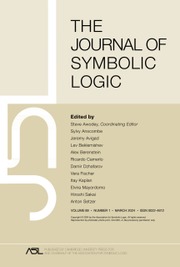Article contents
Automorphisms of supermaximal subspaces
Published online by Cambridge University Press: 12 March 2014
Extract
An infinite-dimensional vector space V ∞ over a recursive field F is called fully effective if V ∞ is a recursive set identified with ω upon which the operations of vector addition and scalar multiplication are recursive functions, identity is a recursive relation, and V ∞ has a dependence algorithm, that is a uniformly effective procedure which when applied to x, a 1,…,an , ∈ V ∞ determines whether or not x is an element of {a 1,…,an }* (the subspace generated by {a 1,…,an }). The study of V ∞, and of its lattice of r.e. subspaces L(V ∞), was introduced in Metakides and Nerode [15]. Since then both V ∞ and L(V ∞) (and many other effective algebraic systems) have been studied quite intensively. The reader is directed to [5] and [17] for a good bibliography in this area, and to [15] for any unexplained notation and terminology.
In [15] Metakides and Nerode observed that a study of L(V ∞) may in some ways be modelled upon a study of L(ω), the lattice of r.e. sets. For example, they showed how an e-state construction could be modified to produce an r.e. maximal subspace, where M ∈ L(V ∞) is maximal if dim(V ∞/M) = ∞ and, for all W ∈ L(V ∞), if W ⊃ M then either dim(W/M) < ∞ or dim(V ∞/W) < ∞.
However, some of the most interesting features of L(V ∞) are those which do not have analogues in L(ω). Our concern here, which is probably one of the most striking characteristics of L(V ∞), falls into this category. We say M ∈ L(V ∞) is supermaximal if dim(V ∞/M) = ∞ and for all W ∈ L(V ∞), if W ⊃ M then dim(W/M) < ∞ or W = V ∞. These subspaces were discovered by Kalantari and Retzlaff [13].
Information
- Type
- Research Article
- Information
- Copyright
- Copyright © Association for Symbolic Logic 1985
References
REFERENCES
- 16
- Cited by

